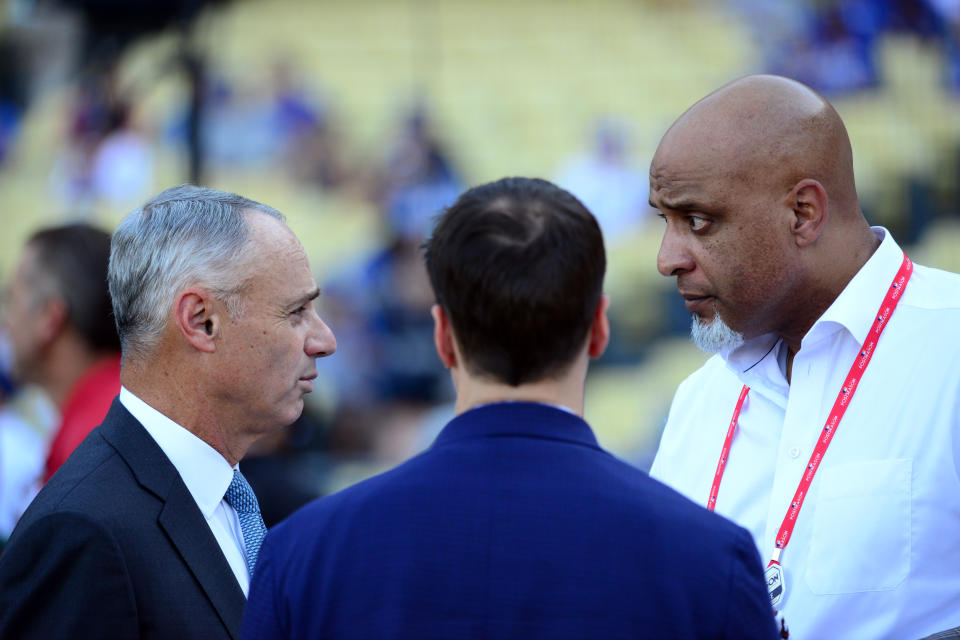Why there will '100 percent' be an MLB season even if players and owners can't strike a deal
The round-and-round that Major League Baseball has put fans through the past few weeks has gotten dizzying. Proposals, disagreements, accusations of operating in bad faith, calls for team owners to open their books — it hasn’t been a good few weeks for MLB.
Another proposal to restart came Tuesday, this time from the players, but it was immediately criticized by team- and league-affiliated sources, who called the whole process a “waste of time,” according to The Athletic.
But here’s the good news: There will almost certainly be an MLB season in 2020, one way or another. Players are saying it. Owners are saying it. And, as the last few weeks have shown us, there’s not much they agree on.
Even commissioner Rob Manfred said Wednesday during an MLB Network interview: "We're going to play baseball in 2020, 100 percent."
How can he be so confident when the gap in negotiations seems so big?
Owners believe they hold a trump card in these negotiations. It may mean players are trudging into the season without actually agreeing to it. And it may also mean that even more of this labor unrest is coming — perhaps even worse.
But if you’re a fan looking for an answer to the biggest question at the end of all this dizzying negotiating and posturing: Yes, you should plan for a baseball season. Almost certainly.
Where things stand between team owners and players
The best way for baseball to restart, both for general happiness in the game now and for the health of things in the future, would be for the sides to come to an agreement. Players and owners, however, aren’t anywhere close to a deal based on the recent proposals.
Money remains the sticking point, with the main issue being a March agreement that players say should give them prorated salaries for the 2020 season. Manfred said Wednesday that owners have another proposal on the way and that he hopes players will back away from their request for prorated salaries.
Everything in this clash is amplified by the fact that the two sides haven’t seen eye-to-eye since the last collective bargaining agreement. Before COVID-19 sidetracked the 2020 season, many in the industry thought MLB was heading toward a work stoppage after 2021. These negotiations have only made the league and the union butt heads even more.
Before we go any further, here’s a reminder of what both sides are after:
OWNERS
Want players to take an additional pay cut, citing lost revenue that will come from playing games without fans.
Their most recent proposal was to guarantee 50 percent of already prorated salaries with an additional 25 percent paid out if the postseason is completed.
Want fewer games to finish the season by the end of September and start the postseason in October. Their most recent proposal, which came Monday, was for 76 games.
PLAYERS
Consider any additional pay cut beyond prorated salaries a “non-starter.”
They want their prorated salaries from the March agreement.
Want to play more games. Their most recent proposal, which came Tuesday, was for an 89-game season.
The difference between 76 games and 89 games doesn’t seem like much, but the real issue is the salary during those games. Players are asking for 89 games at prorated salaries equals 55 percent of their 162-game salaries. Owners asking for 76 games would equal 23 percent of players’ 162-game salaries without the playoffs and 35 percent with the playoffs.

Why MLB will almost certainly be back
As far apart as that sounds, there’s another plan that’s been discussed quite a bit — much to the chagrin of the MLBPA. The March agreement allows Manfred and the owners to start the season and impose any number of games they want if they’re paying prorated salaries. (Just as it allows the players to refuse to discuss any further cuts to their rate of pay.)
With that, it’s been reported recently that the league is ready to mandate a season of 48 games if no other agreement is reached. This would grant the players their full prorated salaries, but cut costs to the levels team owners want by reducing the number of games. (An expanded postseason, proposed by both sides during negotiations, would likely be off if they went this route.)
For comparison’s sake: That 48-game season at full prorated salaries would pay players 29.6 percent of their 162-game salaries.
It could be a shrewd move in some senses by the owners, but it might come with blowback.
What if some players just don’t report to play?
What if someone — a player, an agent, etc. — files an injunction or sues?
But where this could get messier is in the long term. With the current CBA set to expire after the 2021 season, MLB forcing a not-agreed-upon shorter season on players could form the foundation of a strike.
Distrust was already high. Mandating a season? The players union could see that as the opening shot in a war that is looking more and more likely to come after 2021.
That context makes this stand-off even more interesting. Will either side flinch?
Will the owners concede a little bit to the players in an effort to ease tensions in the long run? Will the players accept another pay cut to move things along?
Is finding middle ground even possible?
Getting back on the field is one thing, but that may be the biggest question of them all.
More from Yahoo Sports:

